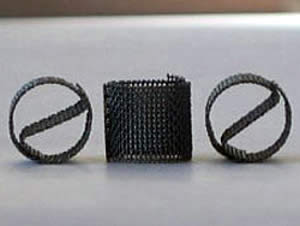
The Dixon Ring was invented by Olaf George Dixon in 1946 and is made from stainless steel mesh material. credit Croft Engineering Services
A UK engineering firm is helping to develop a way of keeping the air clean and safe in deep sea submarines.
Croft Engineering Services is working with two of the country's leading universities to help create a chemical-free system of removing carbon dioxide from the air inside underwater capsules.
As people breathe, they exhale carbon dioxide which needs to be taken out of the air when in a sealed space such as a submarine, to ensure inhabitants stay safe and are not poisoned.
At present, chemicals such as calcium hydroxide are used to do this.
But, thanks to exciting research, a smart process is being developed using thousands of tiny pieces of fine wire mesh, called Dixon Rings, supplied by Croft Engineering Services' manufacturing centre, in Warrington.
Neil Burns, partner of Croft Engineering Services, said: "Dixon Rings are based on technology developed in 1948 â€" due to there size the common 3mm ring has a surface area of 2378m3/m3 which along with there void space of over 90% and HETP as low at 5.88cm they offer the perfect packing for a number of industries including those of submarines in which carbon dioxide can be fatal if left to saturate the air in a submarine.
"Using the rings to take out carbon dioxide from exhaled air is a process that will have many uses and it's a very exciting project to be involved with."
The combination of salt water liquid and the Dixon Rings creates a small 'gas scrubbing unit' that takes out the CO2 and safely discharges it into the sea.
The process of CO2 removal here is know as scrubbing which works by packing thousands of Dixon Rings into a column with gas and liquid flowing counter current to each other.
By developing the technology it is hoped to be able to extend the time submersibles can spend carrying out deep sea work.
